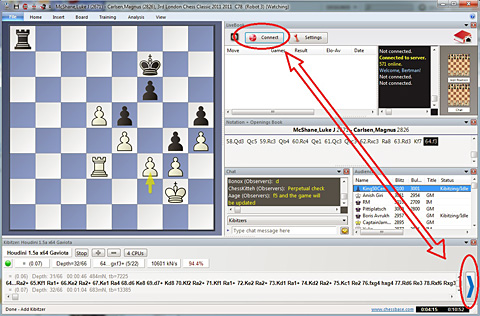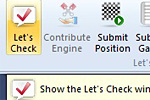Let's Check on Playchess
With the arrival of Fritz 13, and most especially the Let's Check functionality, a lot has been made of the revolutionary effect it will have on openings study and preparation. While unquestionable, it brings more than this to the table. It can also be used to provide very deep game commentary, especially for top games being played now, since spectators are running their engines using Let's Check, and the results of the analysis is stored for future reference. Not only for moves played, but moves that might have been played.
The LiveBook database that is built with Let's Check gives credit to users who discover a previously unknown position, a special badge of honor that is kept even if another user later contributes deeper analysis. That said, it is not enough to simply play a new move to 'discover' it, the move must also be analyzed deeply enough to be stored for the longterm.
The result of this is that many users compete, for the fun of it, to discover the positions of a game underway before they are played, to get credit for their discovery. By the time the game is over, anyone who takes the game and runs a Let's Check analysis will be able to see all these incredibly deep analyses not only of the moves played, but the unplayed variations as well. That way, Let's Check not only allows for a collectively built openings database, but collectively analyzed games as well!
If you'd like to join in, here is how it works:
First connect to Playchess through Fritz 13, and go to the broadcast room. The first step is:
1) Single board, no tiling
Though Playchess allows you to tile multiple boards on the screen, the Let's Check function requires a single-board per screen scenario. To do this, right-click on a board and select Watch in Single Board. You should do this for every broadcast you open to watch.

Open the games selecting Watch in single board
2) Connect to Let's Check
To use Let's Check in Playchess, it is not enough to turn on your engine, you must also manually connect to Let's Check. If you do not, your computer analysis remains private and unshared, however you also won't see the computer analysis of other Let's Check users.

Your engine's analysis will only be contributed to Let's Check if you manually turn it on
3) Enjoy the party
The first thing you will notice is the top analyses done by others. You will also notice in the Livebook, alternate moves just as if these were moves that had been played previously, however this is not necessarily the case. The chances are thse are moves that are being investigated by other users, trying to claim 'discovery' of them as well.

Despite being a completely new position, the LiveBook is showing six possibilities.
These are moves and lines that Let's Check users are investigating while the game
is underway.
4) Stake your claim
While watching a game, you are free to play ahead with moves of your own on the board to analyze possible continuations. When you play a move this way, the notation will add the note "Analysis" before your moves.

If you play moves on the board in a broadcast, you can analyze them for your own
curiosity and to add to the LiveBook.
First play until a move that no one has tried, and then let your engine run on it. Once you start your engine, a handy tip is to right-click on the engine, and enable Lock Engine. The reason is that sometimes the broadcast updates the notation without adding any new moves, and this resets your engine. This prevents the engine from being interrupted. Note that you will need to unlock it to switch analysis to another move.

Locking the engine prevents it from being interrupted
After the analysis line has gone from green to dark blue (it will take a few minutes) you will be declared as having discovered that move.

When the depth is green, your analysis is registered in the LiveBook...

...however once the depth is blue, you become the 'discoverer' of that move.
On top of contributing to a collective effort to share analysis, we hope this side-effect of using Let's Check on Playchess will add an extra twist of fun while watching live broadcasts.

Copyright ChessBase


































